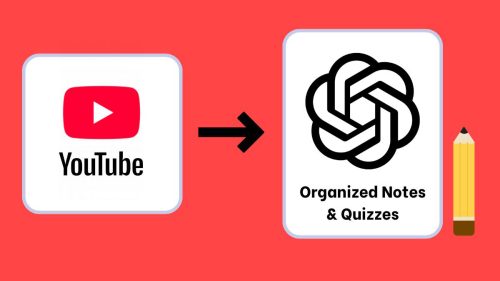AI note taking from YouTube lets students and teachers convert educational videos into organized study notes. This Youtube to notes guide will show you how to extract a YouTube transcript, structure it, & generate study guides, quizzes, flashcards, & more using AI tools like ChatGPT, Gemini, & NotebookLM.
My Youtube to Notes with AI Workflow
Step 1 — Extract the Transcript
Goal: Obtain accurate text from the YouTube lecture.
- Open the video menu → Show transcript → copy the full text.
- If captions are available in multiple languages, choose your preferred language.
- For your own channel videos, export captions from YouTube Studio for highest accuracy.
If you can’t export the YouTube transcript:
- No “Show transcript” option? Use an AI transcription tool to convert YouTube lecture audio to text (e.g., Whisper on the audio file, or a system-audio recorder + transcription).
- Poor auto-captions: Re-transcribe audio with a higher-accuracy model, then proceed with the below steps.
- Permission-first: For non-owned videos, use transcripts for personal/educational use only and respect rights/policies.
Prompt: Extract & Normalize Transcript
-
Act as my transcript assistant. Remove timestamps, normalize casing/punctuation, and join broken lines into paragraphs. Return clean paragraphs only. Transcript: [paste]
Step 2 — Clean & Segment
Goal: Remove timestamps and filler, then structure by topic for downstream assets.
- Strip timestamps and filler; normalize casing and punctuation.
- Add H2 topics and H3 subtopics with 3–5 bullets each.
- Flag unclear names/dates as
[verify]; preserve technical terms and formulas. - Create a 150–250 word executive summary and a 6–12 term glossary.
Prompt: Organize & Clean Notes
-
Clean filler and normalize punctuation. Structure as H2 topics and H3 subtopics; add 3–5 bullets per H3. Tag uncertainties as [verify]. End with a 150–250 word executive summary and 6–12 glossary terms (one-line definitions). Transcript: [paste]
Step 3 — Summarize Key Concepts
Goal: Produce short, focused summaries aligned to the video’s structure.
- For each H2/H3, write a 100–150 word section summary plus 3–5 bullets.
- Include equations, named examples, and definitions to support quick review.
Prompt: Write Section Summaries
-
For each H2/H3 section, write a 100–150 word summary and 3–5 bullets. Include key names, formulas, and examples. Avoid redundancy and keep it scannable. Notes: [paste]
Step 4 — Build a Study Guide
Goal: Turn structured notes into a time-boxed plan.
- Group content into Concepts, Procedures, Examples.
- Add 2 learning objectives per section and a 2-hour study block (4 × 25-minute focus + 5-minute breaks).
- Prioritize by exam weight and difficulty.
Prompt: Create a Study Guide
-
From the structured notes, build a STUDY GUIDE with sections: Concepts, Procedures, Examples. Add 2 learning objectives per section. Create a 2-hour study plan (4 × 25-min focus + 5-min breaks). Prioritize by exam weight. End with 10 must-knows and 5 pitfalls. Notes: [paste]
Step 5 — Generate a Quiz
Goal: Check understanding directly against the video content.
- Create 5 MCQs with plausible distractors and 1-sentence rationales.
- Add 3 short-answer items with target length and grading hints.
- Add 2 application problems; tag each item with its H2/H3 source.
Prompt: Generate a Quiz + Key
-
Generate a mixed QUIZ: 5 MCQ (1 correct + 3 plausible distractors) with 1-sentence rationales; 3 short-answer items (2–4 sentences + grading hints); 2 application problems (show steps/units). Tag each item with its H2/H3 source and provide a printable answer key. Notes: [paste]
Step 6 — Make Flashcards
Goal: Prepare spaced-repetition materials from the lecture.
- Build 10 term-definition cards, 8 process cards, and 7 formula/example cards.
- Use cloze deletions for formulas and ordered steps; keep answers ≤25 words.
- Export Q:/A: lines to Anki or Quizlet for spaced practice.
Prompt: Make Flashcards
-
Create 25 FLASHCARDS: 10 term-definition, 8 process (step order), 7 formula/example (use cloze deletions). Keep answers ≤25 words. Avoid duplicates and near-synonyms. Output as Q: / A: lines for Anki/Quizlet. Notes: [paste]
AI Copy-Ready Prompts
Use these youtube to notes ai prompts on any YouTube lecture. Start with transcript cleanup, then structure by topic, then generate a study guide, quiz, and flashcards. Bookmark this page and share it with students and colleagues. Explore the full AI Note Taking Hub for other inputs and tools.
Extract & Normalize the YouTube Transcript
-
Act as my transcript assistant. If text includes timestamps, remove them. Normalize casing and punctuation. Join broken lines into paragraphs. Return clean paragraphs only. Transcript: [paste]
Organize & Clean Notes
-
Clean filler. Structure as H2 topics and H3 subtopics. Under each H3, add 3–5 bullets. Tag uncertainties as [verify]. End with a 150–250 word executive summary and 6–12 glossary terms (one-line definitions). Use any timestamps as references in parentheses. Transcript: [paste]
Write Section Summaries
-
For each H2/H3 section, produce a 100–150 word summary with 3–5 bullets. Include key names, formulas, and examples. Keep sections scannable and avoid redundancy. Notes: [paste]
Create a Study Guide
-
From the structured notes, build a STUDY GUIDE with sections: Concepts, Procedures, Examples. Add 2 learning objectives per section. Create a 2-hour study block (4 × 25-min focus + 5-min breaks). Prioritize by exam weight. Finish with 10 must-knows and 5 pitfalls. Notes: [paste]
Generate a Quiz + Key
-
Generate a mixed QUIZ: 5 MCQ (1 correct + 3 plausible distractors) with 1-sentence rationales; 3 short-answer items (2–4 sentences + grading hints); 2 application problems (show steps/units). Tag each item with its H2/H3 source and provide a printable answer key. Notes: [paste]
Make Flashcards
-
Create 25 FLASHCARDS: 10 term-definition, 8 process (step order), 7 formula/example (use cloze deletions). Keep answers ≤25 words. Avoid duplicates and near-synonyms. Output as Q: / A: lines for Anki/Quizlet. Notes: [paste]
YouTube to Notes with AI: FAQs
Can AI summarize any YouTube lecture?
Yes. Use the built-in transcript when available or convert YouTube lecture transcript with a transcription tool, then run the clean-and-structure prompt.
Is using the transcript allowed?
Use transcripts for personal or educational purposes. Do not redistribute copyrighted content.
Which tool should I use?
ChatGPT is flexible; Gemini handles multimedia well; NotebookLM excels at grounded notes with citations.
How do I handle long videos?
Process 20–30 minute chunks or 2–3k-word segments. Merge and re-summarize at the end.
What should I export?
Save notes as .txt/.docx; youtube transcript to study guide as .docx or PDF; flashcards as .csv for Anki/Quizlet. Version files like Course-YYYY-MM-DD-v1.
Conclusion
Use AI note taking from YouTube to move from video to transcript to structured notes to study guide, quiz, and flashcards effectively. This guide targets the Youtube workflow and complements our tool-specific ChatGPT guide here. Visit our AI Note Taking Hub to find all effective workflows and browse the Best AI Note Takers to stay in the know.
Happy Youtube note taking!




